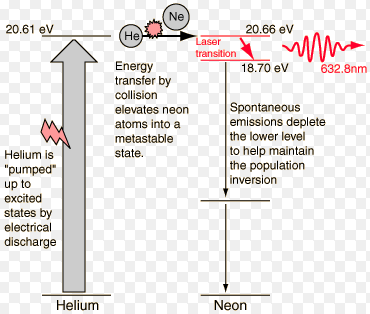Helium (he) Neon (ne) laser working animation
Helium-Neon Laser
A helium-neon laser, usually called a He Ne laser, is a small gas laser. Its usual operation wavelength is 632.8 nm, in the red portion of the visible spectrum.
Construction:
Working:
It is the most common type of laser used in physics laboratories. Its discharge tube is fitted with 80% helium and 20% neon gas. The neon is the lasing or active medium in this tube. By chance, helium and neon have nearly identical metastable states, located at 20.61 eV and 20.66 eV respectively. The high voltage electric discharge excites the electrons in some of the helium atoms to the 20.61 eV state.
In this laser, population inversion in neon is achieved by direct collisions with the same energy electrons of helium atoms. Thus excited helium atoms collide with the neon atoms, each transferring its own 20.61 eV of energy to an electron in the neon atom along with 0.05 eV of K.E. from the moving atom. As a result, the electrons in neon atoms are raised to the 20.66 eV state.
This process is given by the reaction equation:
He∗ +Ne →He + Ne∗ +ΔE
where (*) represents an excited state, and EΔ is the small energy difference between the energy states of the two atoms, of the order of 0.05 eV.

In this way, a population inversion is sustained in the neon gas relative to an energy level of 18.70 eV. Spontaneous emission from neon atoms initiates laser action and simulated emission causes electrons in the neon to drop from 20.66 eV to the 18.70 eV level and red laser light of wavelength 632.8 nm corresponding to 1.96 eV energy is generated.
Related topics:
